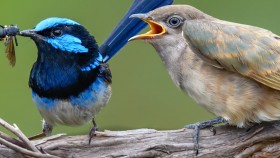Chris Fulton
Lab research
The Fulton Lab explores patterns of aquatic biodiversity in relation to environmental variability across space and time. Our recent work has examined how and why patterns of taxonomic, morphological and physiological diversity in fishes, crayfishes and seaweeds vary across gradients of water flow and temperature.
Greatest achievement
Demonstrating that the distribution patterns of reef fishes across gradients of wave energy could largely be explained by differences in their swimming ability: fast-swimming fishes typically occupy wave-swept habitats, while slower swimmers are restricted to calmer waters. This spatial assembly rule has since been tested multiple times and found to be valid for reef fishes occupying coral and rocky reefs across the Indo-Pacific and Caribbean, regardless of any differences in the species pool present at each location.
Next big thing
Species that can persist in habitats subject to extreme environmental conditions (both in terms of variability and magnitude): such extremophiles could really push the limits of our understanding on how organisms can vary their phenotype to deal with abiotic stress.
What do you see as future challenges for your field of research?
One of the main challenges we face is ensuring observer safety when working at the extreme ends of our environmental gradients. To push the boundaries of our field, we are going to need innovative approaches and technologies to be able to safely record the aquatic organisms doing their stuff under the harshest of field conditions.
Outreach activity
Chris Fulton and Mae Noble from the ARC Centre of Excellence for Coral Reef Studies visited eight NSW High Schools to talk with students about some of the exciting discoveries they've made recently in marine ecosystems on the NSW coast, share their stories of how they left rural towns to study at university, and explain what it means to be a marine scientist. These outreach activities are done in co-operation with ANU Student Equity as part of the ANU Regional Partnerships Program. Over 300 regional secondary school students had the opportunity speak directly with Chris and Mae.
- This profile originally appeared in the RSB newsletter, issue 45, July 2013.
- Fulton Lab - Ecology and evolution of fishes








